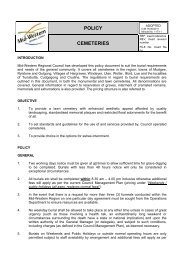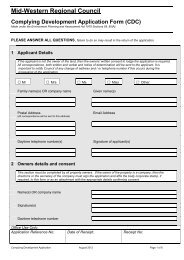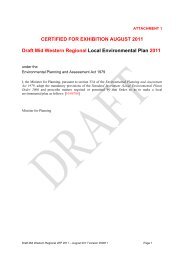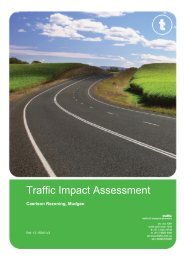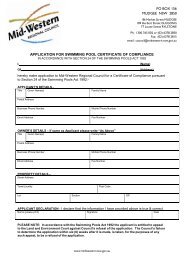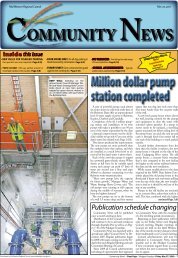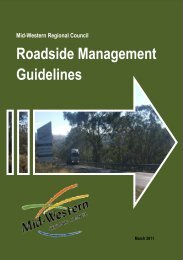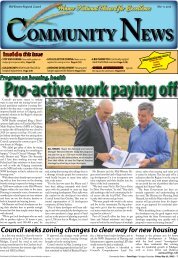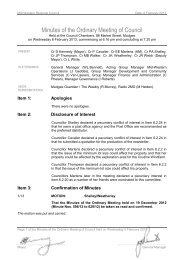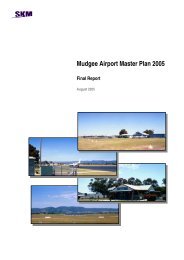preliminary soil salinity assessment - Mid Western Regional Council
preliminary soil salinity assessment - Mid Western Regional Council
preliminary soil salinity assessment - Mid Western Regional Council
You also want an ePaper? Increase the reach of your titles
YUMPU automatically turns print PDFs into web optimized ePapers that Google loves.
3.2 Current Salinity SituationAccording to results of the laboratory analysis and taking into account <strong>soil</strong> textures, <strong>soil</strong> <strong>salinity</strong>levels within the sampling depth across the six sites are low.Laboratory results indicate that <strong>salinity</strong> is slightly elevated in the lower sub<strong>soil</strong> (C Horizon 40 –100cm) at Site 4 with an EC e of 1.75dS/m. Although this is below the Non-Saline threshold of 2.0dS/m, considered in the wider context of local drainage, site history, saline material found deeper inthe profile from drilling in the region (Environmental and Earth Sciences, 2007), and elevatedchloride levels in the sub<strong>soil</strong> at Site 6, there may be salts deeper in the profile in the low lying areaaround Site 4 and Site 6 that are naturally occurring or have accumulated due to leaching,waterlogging or groundwater.Site 6 recorded slightly elevated chloride levels in the top<strong>soil</strong> (A Horizon) and lower sub<strong>soil</strong> (CHorizon) and slightly sodic lower sub<strong>soil</strong>, however electrical conductivity was found to be low. Thismay be a result of leaching of chlorides from the adjacent leachate ponds or due to natural occurring<strong>soil</strong> chemistry deeper in the profile in this low lying, natural drainage depression area (as shown onthe topographic map in Appendix B: Current Site Layout, Topography and Soil Pit Locations).Sodic <strong>soil</strong> was found at three of the six sites in the lower sub<strong>soil</strong> with Sites 1 and 4 considered highlysodic (DLWC, 2002). Highly sodic <strong>soil</strong>s are usually dense with low permeability and disperse whenwet (Hazleton and Murphy, 2007). This causes sodic <strong>soil</strong>s to be generally prone to poor waterinfiltration and erosion and may lead to perched water tables above the sodic material.Based on the limited number of <strong>soil</strong> pits, depth of sampling, and <strong>soil</strong> laboratory analysis results,current <strong>soil</strong> <strong>salinity</strong> down to approximately one meter appears to be low. However, when thesefindings are considered in addition to the slightly elevated EC e of top<strong>soil</strong> sampled at Site 1 andsub<strong>soil</strong> sampled at Site 4 in the low lying drainage area, slightly elevated chloride levels at Site 6(also in the low lying drainage area), presence of extensive areas of kikuyu and couch on lowerslopes and flats, site history with possibility of leached salts deeper in the <strong>soil</strong> profile, and incidenceof <strong>salinity</strong> in other sites in the local area, urban development at the site is considered to have a low<strong>salinity</strong> hazard on the mid to upper slopes and a low to moderate <strong>salinity</strong> hazard on the lowerslopes and low lying areas. In addition, site conditions may change under different conditions suchas a series of high rainfall years. Therefore, any future urban development of the subject land shouldadopt a precautionary approach to <strong>salinity</strong> management including adoption of the principles ofBuilding in a Saline Environment (DIPNR, 2003).3.3 Implications for Urban Development at the SiteThe construction of subdivisions has the potential to alter any existing <strong>salinity</strong> both within thisdevelopment and in surrounding areas due to changing landform, varying the vegetation in rechargeand discharge areas, siting of infrastructure and services, and water management associated withdevelopments. Therefore, residential subdivision developments need to be undertaken in a <strong>salinity</strong>sensitive manner otherwise urban land use may result in <strong>salinity</strong> issues in areas with even a low<strong>salinity</strong> hazard (DLWC, 2005).PRELIMINARY SOIL SALINITY ASSESSMENT23



